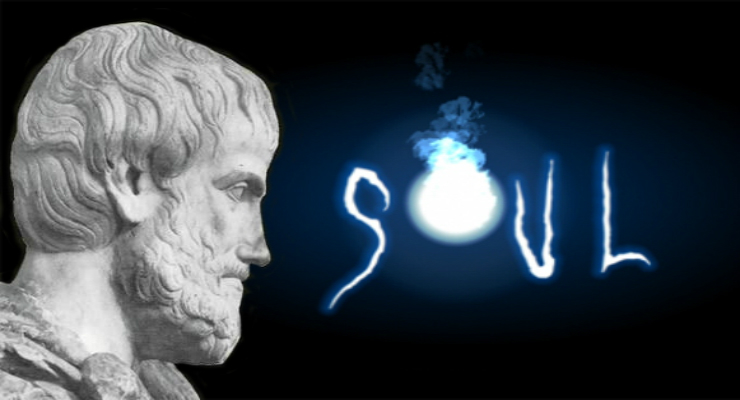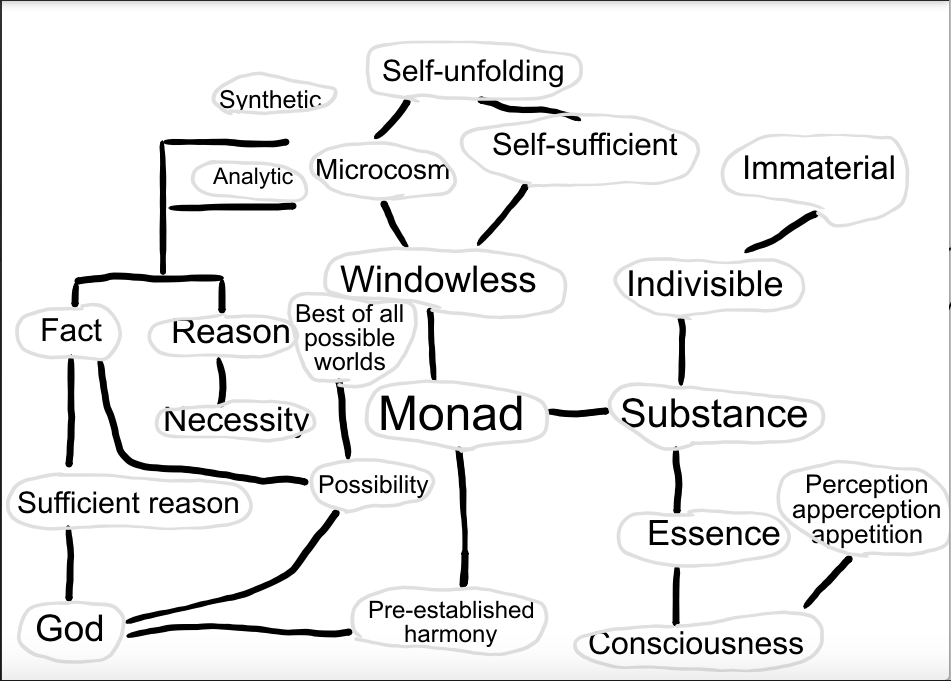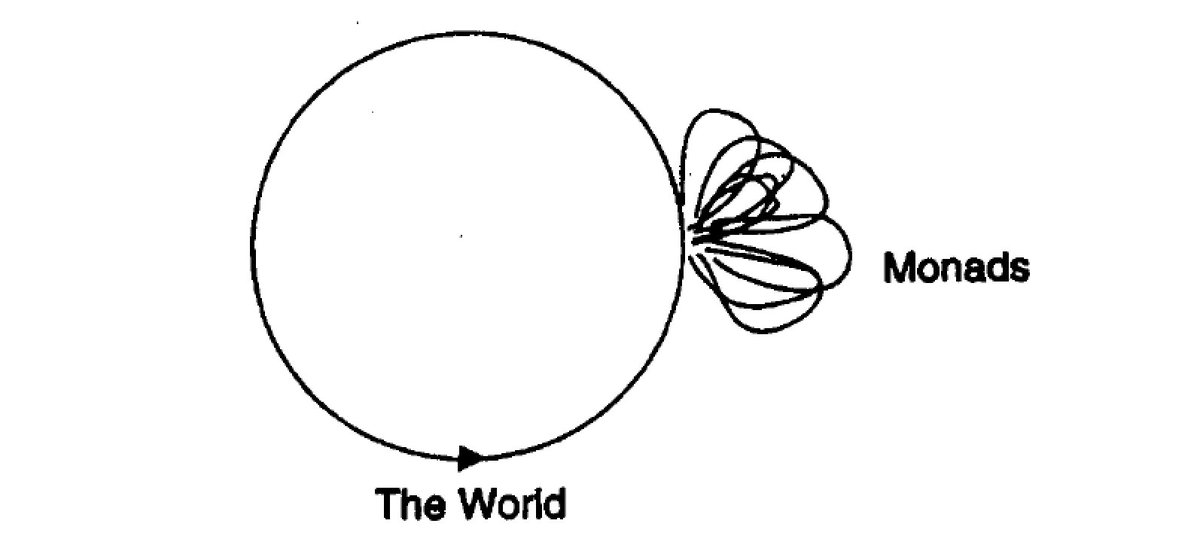By Penny Theodorakopoulou,
Previously, we talked about the two arguments that, according to G. W. Leibniz, prove that God exists: the ontological argument and the contingency argument (available here). At the end of both of his arguments, and more specifically on his contingency argument, Leibniz mentions that God is the “Monad of Monads”, the primary Monad. But what exactly is a “Monad”, and why did Leibniz decide to write a whole book regarding Monads?
Before we talk about God as the primary Monad in Leibniz’s Monadology, it would be reasonable to state what a Monad is. So let us take things from the very beginning.
Beginning the writing of Monadology, Leibniz makes it clear from the beginning that “Monad, of which we shall speak here, is nothing but a simple substance which enters into the composites; simple, that is, without parts”. So what is substance? First and foremost, it is not a term that we encounter for the first time. More specifically, it has roots in ancient Greece, and specifically from Aristotle. Aristotle, in his work On the Soul (Greek: Περί Ψυχῆς), thoroughly analyzes what the soul is, trying to find a definition for it and analyzing each time the terms he gives a definition. In the first definition he gives (“The soul is a substance as a form of a physical body possessing potential life”), he introduces some concepts. He first introduces the concept of substance, stating that it consists of form (or species), matter, and the union of form and matter (composite).

Having referred to On the Soul and having said the above, we can conclude that the being is an essence, it is the subject, the individual living thing. The compound is the first essence, the individual, while the genus and species constitute the second essence, the whole. Genus and species are the most fundamental property of a being. Let us give an example to make it more distinct. Suppose we have the sentence “Socrates is a man”. As the first substance, we take Socrates; he is the subject of the main sentence for a few reasons. The second essence is the man because if he were not man, Socrates could not exist as a being. The rest of the properties we attribute to beings (e.g. Socrates is an Athenian/short/philosopher/hangs around in the marketplace) are accidental properties of the first essence (contingent; Greek: συμβεβηκότα).
The terms “essence” and “substance” are identical, and since the Monad is substance, according to Leibniz, then it is also essence. We notice at this point that Aristotle had a great influence on Leibniz and how to define the Monad. Nevertheless, we can — and should — quote how Leibniz defines the Monad. As §1 of Monadology mentions, the Monad is a simple substance (substance simple), which enters into the composites (composés). Let us first study the term substance according to Leibniz.
The essence, as Aristotle himself believes, is a characteristic of all beings, animate and inanimate. More specifically, the essence of a being is not the individual characteristics that are given to it, but it is that one characteristic that makes the being a being; speaking in Aristotelian terms, the essence is, as we mentioned above, form, matter, and composite, the which is the first essence, while genus and species are the second. To better understand the thoughts of both philosophers, let us give an example. Suppose we want to define the chair. As a component/characteristic, we will not define the material from which it is made, but we will define what a chair is, and what makes a chair, a chair. In short, we are looking for the utility of the chair, the work performed by an ordinary chair. What does a chair look like and what is its function? A chair is, according to Wikipedia, “a type of seat, typically designed for one person and consisting of one or more legs, a flat seat, and a backrest. They may be made of wood, metal, or synthetic materials, and may be padded or upholstered in various colors and fabrics”. This definition applies to any kind of chair, regardless of how many legs it has or how it is made. So this is its essence, which, however, also consists of random properties (e.g. color, shape, height: contingent).

We mentioned that Leibniz defined essence as a characteristic of beings. And as we demonstrated with the chair example, substance is comprised of features that “exist” (first substance, second substance) and other features that “are accidental” (contingent). Leibniz clarifies from the very first paragraphs (§1-2) that substance is just substance, which enters the composites. From the above, the composite consists of form and matter, of two individual parts. This is precisely what Leibniz explains in §2: “[…] The complex is nothing but a heap or aggregatum of simples”. Many simple and individual phenomena, if aggregated, will become a complex substance, like an organism, one might say.
Since the composite is composed of parts, the parts are not composed of other parts. Monads, according to Leibniz, cannot be further divided — they are substances without parts. Be that as it may, we move on to §3, which emphasizes that Monads have no extent, no shape, and cannot be further divided. He characterizes these kinds of Monads as “the true atoms of nature”, “the elements of things”. Calling the simple Monads “individuals”, under no circumstances must we confuse this term with the concept of atomism. According to that, “an atom is the smallest unit of ordinary matter that forms a chemical element. Every solid, liquid, gas, and plasma is composed of neutral or ionized atoms. Atoms are extremely small, typically around 100 picometers across. They are so small that accurately predicting their behavior using classical physics as if they were tennis balls, for example, is not possible due to quantum effects”. The atoms of this definition cannot be divided, but have a certain extent, a certain shape, and move in space. Monads are indeed indivisible, but without extent, shape, and the possibility of division. Therefore, atoms, according to the definition given above, do not exist as true atoms, but as Monads.
Since Monads are the elements of things, there is no fear of their dissolution and division in order to perish naturally, as Leibniz points out in §4. Taking this for granted, he continues his flow by adding that, since it is impossible [for Monads] to perish naturally, it is equally impossible to begin in the first place. The reason is quite simple: it is not possible for simple substances to be formed by composition, for they are simple, arbitrary, one might add. We come to the conclusion, based on what has been said, that “Monads cannot begin, nor end except at once; they cannot, that is, begin except with creation and end only with annihilation”. The composite, on the other hand, since it consists of parts, can begin and end in parts.

Ending with the concept of the Monad in the eponymous work, Leibniz expresses some facts, as well as his personal thoughts regarding Monads, which, as we just mentioned, cannot begin and perish naturally. So, in §7, he initially fails to find a logical explanation of how a Monad can be altered or changed, complicating things and adding suspicion. He adds, however, that while composites can change and cease to exist, owing to the constant change of parts within parts, Monads, because they are simple, do not have this possibility; they cannot either do their essence change or do any properties of Monads change because they are nowhere for that to happen. Without space, extent, size, and even shape, it is impossible to change simple Monads.
In the final part of analyzing Leibniz’s Monadology, we will discuss how God is the primary Monad.
References
- G. W. Leibniz, La Monadologie – Η Μοναδολογία, εισ. Γεράσιμος Βώκος, μτφρ. Στέφανος Λαζαρίδης, εκδόσεις Υπερίων – Φιλοσοφία, 1997
- Αριστοτέλης, Περί Ψυχής, μτφρ. Κ. Τατάκης, εκδόσεις Ζαχαρόπουλος, Αθήνα, 1958, Α’ Β’ Βιβλίο
- Atom, wikipedia.org, Available here
- Monadology, wikipedia.org, Available here
- Bobro, M., & Clatterbaugh, K. (1996). Unpacking the Monad: Leibniz’s Theory of Causality (Vol. Vol. 79). The Monist, jstor.org, Available here
-
Leibniz, G. W. (1902). Discourse on Metaphysics, Correspondence with Arnauld and Monadology. (T. J. McCormack, Ed.) New York, United States of America: 1873 Press.
-
Taylor, R. (1991). Metaphysics (4th edition ed.). Prentice Hall.




